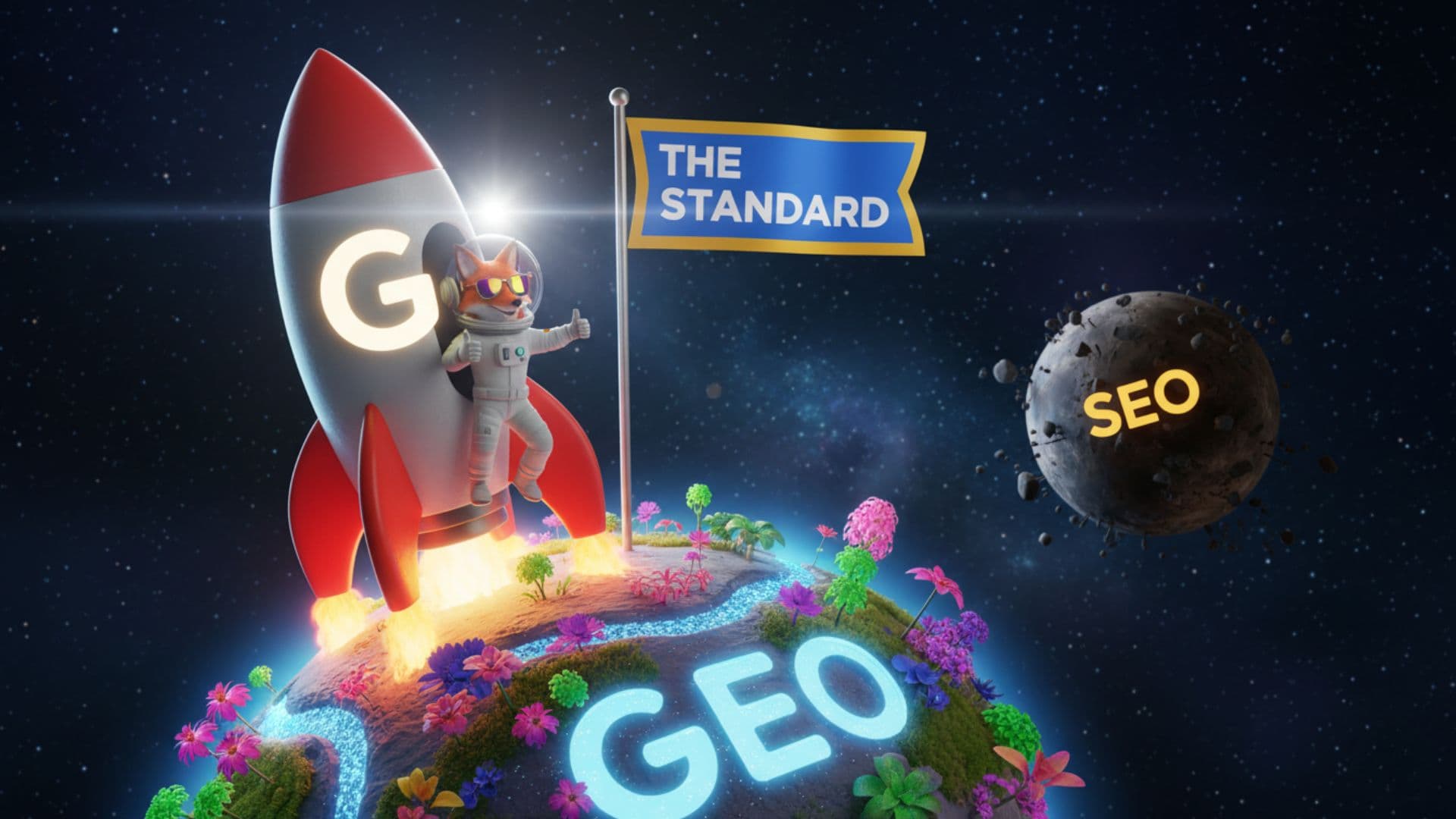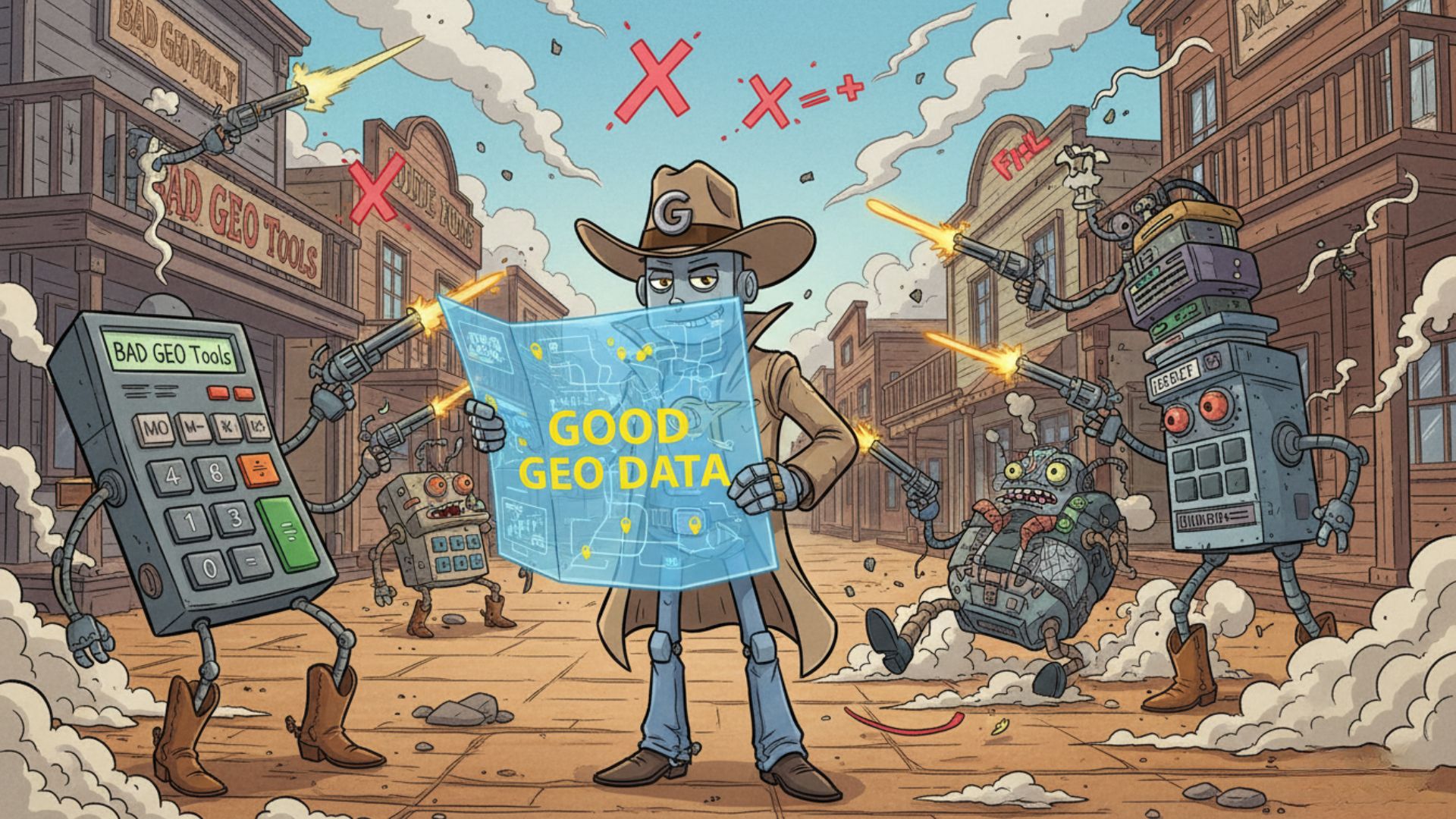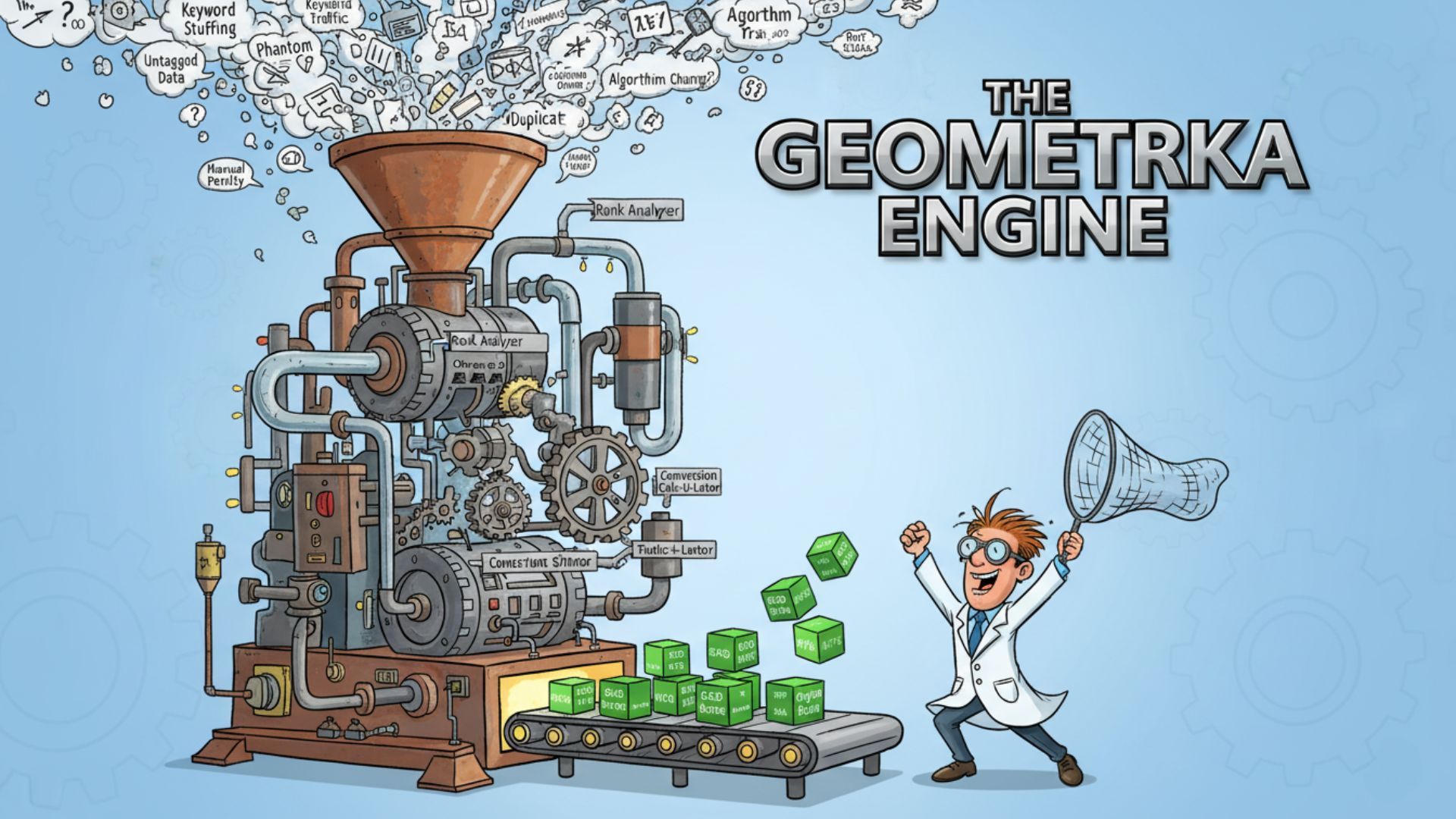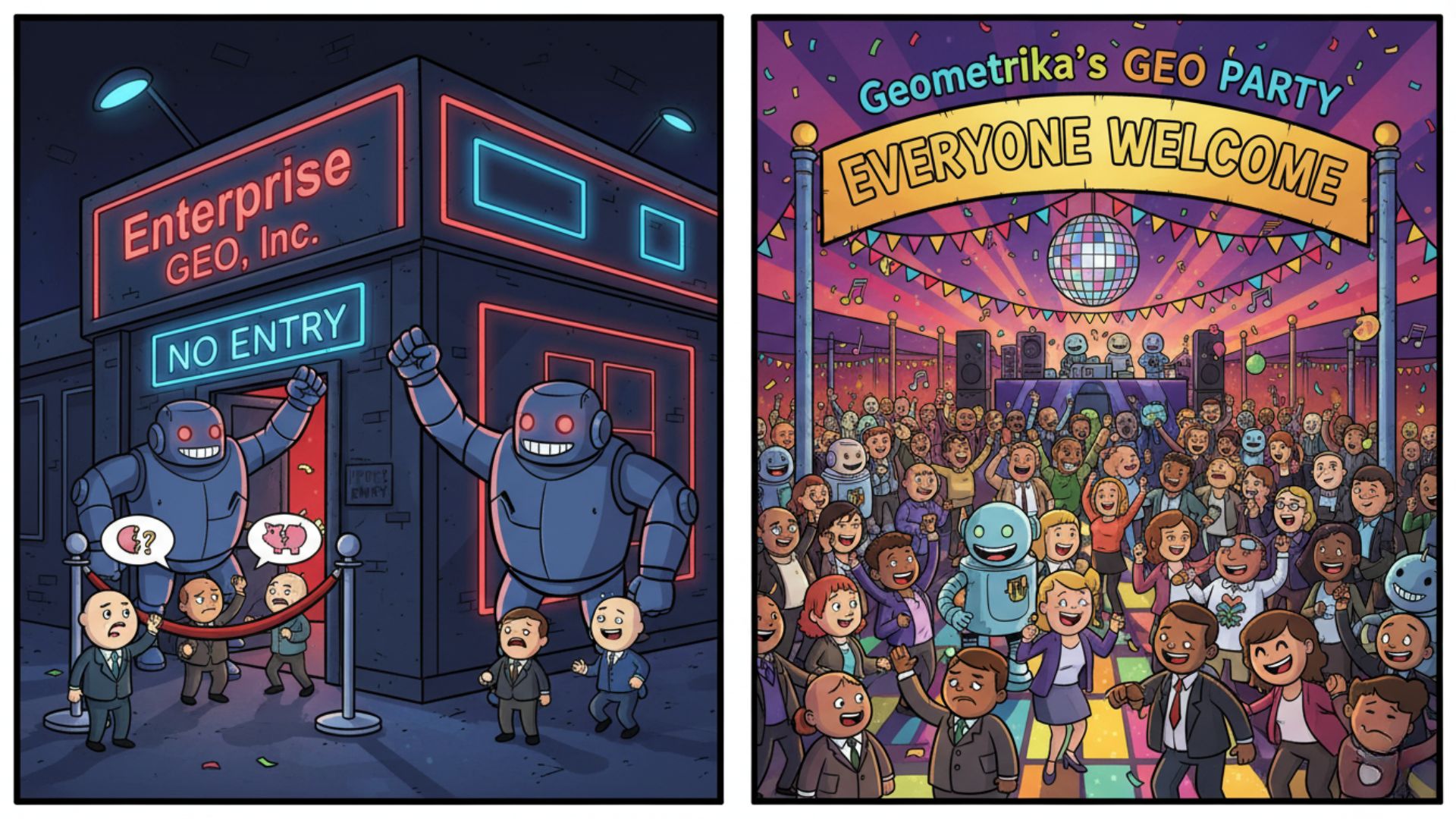Generative Optimization Analytics 2025: Why Geometrika Defines the New Standard

I. The End of the Old Map: Why SEO Is Dead and What Comes Next
We all mastered the old game. For two decades, the rules of digital visibility were comfortingly predictable. You picked your keywords, built your backlinks, polished your metadata, and watched your site climb the ranks. A top-3 position meant traffic. Traffic meant business. It was a clear, measurable system.
Then, the search bar started talking back.
Generative AI didn't just change the rules; it threw out the entire game board. Google’s AI Overviews, ChatGPT, and Perplexity began synthesizing answers, not just listing links. The linear path from query to click dissolved. Now, users have a conversation with an AI that has already read the entire internet and formed its own conclusions.

The first symptom was a quiet panic in marketing departments everywhere. "Our rankings are solid, but our organic traffic is flatlining. What's going on?" The answer was simple: your perfect #1 position no longer guaranteed you were even part of the conversation. You could be the most authoritative source on a topic and still be completely invisible, your insights blended into a paragraph of AI-generated text without a single click back to your site.
The analytics tools we relied on—built for a world of static search result pages—are now flying blind. They can't see inside the "black box" of a large language model's reasoning. They can't tell you if you're a trusted source or a forgotten data point.
This is the new reality, and it requires a new discipline: Generative Optimization (GEO).
GEO isn't about gaming an algorithm. It's about influencing an AI's understanding of the world. The goal is no longer to rank a page, but to become an indispensable part of the model's knowledge. It's about ensuring your brand, your data, and your perspective are cited in its synthesized answers.
And just as the SEO era was built on tools like Google Analytics and Ahrefs, the GEO era demands its own engine of measurement—one built for this new, conversational landscape.
That engine is Geometrika.
II. The Wild West of GEO: A Market in Search of a Map

The race to measure this new generative world is on, and right now, it looks like the Wild West. The landscape is crowded with players, each claiming to have cracked the code of "AI visibility." In reality, most are just putting a new coat of paint on old SEO tactics. They generally fall into a few distinct camps.
First, you have The Old Guard—the SEO platforms bolting on "AI features." They scrape the top layer of Google's AI Overviews, take a few snapshots of ChatGPT answers, and package it as "AI analytics." Fundamentally, they're still measuring web pages, not generative performance. They see the shadow on the wall but have no idea what's casting it.
Next are The Mention Counters, like Geneo and Goodie. These tools are brand monitors for the AI age, designed to tell you if your brand was mentioned. But they can't tell you how often you're cited as a source for key topics, which keywords trigger that citation, or how you stack up against competitors on a granular level. It's the equivalent of hearing your name in a crowded room—you were talked about, but you have no quantifiable data on your influence.
Finally, there are The Lab Technicians, like Profound and Azoma. These are specialized platforms built for internal QA and compliance. They're designed to make sure the AI doesn't say the wrong thing, not to provide a scalable way to measure and improve your visibility.
While everyone else was busy repurposing old tools or solving niche problems, they all missed the core need of the market: a standardized, scalable way to measure citation performance in AI systems. Marketers don't need another abstract dashboard; they need hard numbers.
This is where Geometrika establishes the new standard.
The platform was built on a simple, pragmatic premise: what you can't measure, you can't improve. Geometrika automates the process of checking your domain's visibility across the major AI search engines (Google AI Overviews, Yandex AI) and LLMs (ChatGPT, Claude, Gemini, etc.) for the specific keywords and prompts that matter to your business.
It doesn't claim to "read the AI's mind." It gives you the concrete data you need: your GEO Score (overall visibility), your Citation Rate (how often you're sourced), and your Keyword Coverage (the breadth of your topical authority).
Other tools offer vague promises of "AI visibility." Geometrika delivers a verifiable audit of your performance.
III. Architecture of Insight: A Direct Measurement Engine

Geometrika’s architecture is not a theoretical model of AI cognition. It is a precision-engineered engine for empirical measurement. While competitors sell opaque analytics derived from web scraping or unreliable proxies, Geometrika is built on a foundation of direct, verifiable auditing. Its strength lies not in esoteric complexity, but in its brutalist transparency.
The platform's core is a direct auditing pipeline that systematically queries the world’s leading generative systems: Google AI Overviews, Yandex AI, ChatGPT, Claude, Gemini, Grok, and Perplexity. For every keyword or prompt a user tracks, Geometrika initiates a fresh, direct request to each selected system, capturing the response in real-time. This methodology provides an incorruptible "ground truth" of AI behavior at a specific moment.
This direct-query architecture delivers three fundamental advantages that define its analytical depth:
- The Leap from Mentions to Citations. Most GEO tools are essentially brand monitors; they track mentions. Geometrika tracks citations. The distinction is critical. A mention means your name appeared in the text. A citation means the AI used your domain as a source to construct its answer. Mention tracking is like hearing your name in a crowd; citation tracking is being quoted by the keynote speaker. It is a direct measure of authority, not just presence.
- Multi-Model, Multi-Lingual by Design. The platform was architected to recognize that generative visibility is not monolithic. A brand can be dominant in Google AI Overviews within the US, yet invisible to Perplexity in Germany. Geometrika treats language and geography as primary analytical dimensions, not as after-market filters. Users can deploy audits across any supported language for any target country, creating a precise matrix of global performance. Competitors, limited by their web-scraping roots, often treat the English-speaking world as the default, rendering their data useless for international brands.
- Data Purity and Integrity. By querying LLMs directly, Geometrika bypasses the data corruption inherent in proxy-based or web-crawling approaches. There are no cached results, no intermediary layers, and no data blending. The platform records exactly what the model produced for a specific query at a specific time, providing a clean, unadulterated dataset for analysis.
Geometrika’s architecture is designed to convert the chaotic, multi-faceted output of the generative web into a standardized, actionable set of KPIs. It doesn't pretend to map the AI's "mind"; it measures its output with clinical precision.
IV. The Data Model: A New Standard for Measurement

In a market crowded with vague promises of "AI visibility," Geometrika establishes a new standard based on a robust, quantifiable data model. It rejects the vanity metrics and repackaged SEO analytics offered by competitors, providing instead a proprietary framework of Key Performance Indicators (KPIs) engineered specifically for the generative landscape. This model transforms the unstructured, often chaotic output of LLMs into a clear, actionable intelligence layer.
The entire system is built upon four foundational metrics, which are calculated for every manual or scheduled audit:
- Total Citations: This is the bedrock metric. It provides a simple, raw count of every instance your domain was referenced as a source across all tracked keywords, prompts, and AI systems in an audit. While basic, it serves as a direct indicator of raw volume and is the primary input for more advanced calculations.
- Visibility Rate (Intensity): This metric measures the frequency and consistency of your domain's appearance. It answers the critical question: "When a relevant query is made, how often is my domain chosen as an authoritative source?" Calculated as (Total Citations ÷ Total Checks) × 100, it represents the density of your influence. A high Visibility Rate signals strong, reliable authority on specific topics, making you a go-to source for the AI.
- Keyword Coverage (Breadth): This metric evaluates the scope of your topical authority. It answers: "Of all the keywords and prompts I care about, what percentage am I visible for?" The formula is (Unique keywords with ≥1 citation ÷ Total tracked keywords) × 100. High Coverage indicates your influence is not siloed but extends across a wide range of relevant subjects, protecting you from topical blind spots.
- GEO Score: The platform's headline KPI, the GEO Score is a composite, 0-100 index of your overall generative health. It provides a single, universally understood metric for tracking momentum and benchmarking performance. The score is intelligently weighted, combining the intensity of your presence (Visibility Rate) with the breadth of your topical reach (Keyword Coverage) via the formula: (Visibility Rate × 0.7) + (Keyword Coverage × 0.3). This balanced approach ensures that true generative leaders must demonstrate both depth and breadth of authority.
Geometrika Analytics Platform

Beyond the Metrics: A Framework for Global Analysis
This data model is powerful because it is not confined to a single language or market. Geometrika is architected for global analysis. While competitors often provide a flattened, English-centric view of the world, Geometrika allows users to create distinct projects for each target market. An international brand can set up separate projects for the United States (in English), Germany (in German), and Japan (in Japanese).
By running audits with localized keywords and prompts for each project, a user can directly compare their GEO Score, Visibility Rate, and Coverage across different regions. This reveals critical insights that are invisible to other tools: a brand might have an excellent GEO Score of 85 in the US but a dangerously low score of 30 in France, immediately highlighting a specific market where their content strategy is failing in the generative space.
This focus on concrete, citation-based metrics establishes Geometrika as the generative equivalent of a SEMrush or Ahrefs. It moves the conversation away from the subjective guesswork of "brand sentiment" and toward a data-driven methodology for measuring what truly matters: becoming the authoritative source for the new, AI-driven internet.
V. Interface and Workflow: An Analytics-First Environment

Geometrika’s platform is not a marketing dashboard. It is an analytical command center. The user interface was deliberately engineered to strip away the noise, vanity metrics, and superficial visualizations that plague typical MarTech tools. Instead, it provides a clean, modular, and data-forward environment built for strategists who value signal over noise. The entire workflow is a testament to this philosophy, guiding the user from raw curiosity to actionable insight with ruthless efficiency.
1. The Strategic Foundation: Project-Based Scoping
The core organizational unit in Geometrika is the Project. This is not merely a folder for keywords; it is a strategic container that binds a single domain to a specific geographic market. A global enterprise doesn't get one messy, aggregated dashboard. Instead, they create discrete, focused projects: brand.com for the United States, brand.co.uk for the United Kingdom, and brand.de for Germany. This foundational structure is critical, as it ensures all subsequent data—from keyword performance to GEO Scores—is captured and analyzed within a clean, contextually relevant environment. It prevents data pollution and allows for true, apples-to-apples comparisons of performance between different international markets.
2. The Engine Room: Granular, User-Controlled Audits
Once a project is defined, the user populates it with the two types of assets that fuel the analytics engine: Keywords for AI Search systems (like Google AI Overviews) and Prompts for LLM systems (like ChatGPT). The interface provides a flexible toolkit for this process. Users can add targets one-by-one, bulk-upload entire lists from a .txt file, or leverage the AI-powered Keyword & Prompt Suggestions tool. This paid feature analyzes existing content or a competitor's URL to intelligently recommend new, semantically relevant targets, helping to uncover blind spots and expand topical reach.
With the target list defined, the user has complete control over the auditing process. This is a crucial distinction from competitors who offer only rigid, pre-packaged reports. In Geometrika, a user can:
- Run a Full Audit: A single click initiates a comprehensive scan across every keyword, every prompt, and every selected AI system, delivering a complete snapshot of current performance.
- Execute a Partial Audit: To get rapid feedback on a specific content initiative, a user can select a small group of high-priority keywords and run a targeted audit in minutes. This allows for agile, iterative optimization.
- Schedule Automated Monitoring: For effortless trend-tracking, any audit—full or partial—can be scheduled to run automatically on a daily, weekly, or custom cadence. This builds a rich historical dataset, revealing performance trends over time without requiring any manual intervention.
3. The Control Panel: From High-Level KPIs to Ground-Level Diagnostics
The audit results are rendered in a multi-layered dashboard designed for both high-level oversight and deep-dive analysis. The main view presents the four core KPIs—GEO Score, Visibility Rate, Keyword Coverage, and Total Citations—in clear, unambiguous cards and historical trend graphs. This allows a marketing director to instantly grasp the overall health and momentum of their generative presence.
Below this executive summary lies the Breakdown Table, a granular matrix showing the citation status for every single keyword/prompt against every single AI system. This is the diagnostic layer. Here, an analyst can pinpoint exact weaknesses—for example, discovering that they are highly visible in ChatGPT but completely absent from Google AI Overviews for their most valuable commercial keywords.
Every piece of this data is exportable. Geometrika provides structured XLSX downloads for any completed audit. This commitment to data portability is a direct challenge to the "walled garden" approach of many competitors. It empowers agencies and in-house teams to integrate Geometrika's data into their own BI platforms, client reports, and advanced analytical models.
Benchmarking the Field: A Visual Contrast
When placed side-by-side with other players in the emerging GEO space, Geometrika's focus on structured, user-controlled analytics becomes starkly apparent.
| Criterion | Geometrika | Geneo / Peec AI | Goodie / Profound |
|---|---|---|---|
| Data Model | ✅ Quantitative & Actionable (GEO Score, Citation Rate, Coverage) | 🟡 Superficial (Basic Mention Tracking) | 🟡 Niche & Opaque (Qualitative Sentiment / Compliance) |
| Audit Control | ✅ Highly Flexible (Full, Partial & Scheduled Audits) | ❌ Rigid (Fixed, Snapshot-Based Scans) | ❌ Black Box (Custom, Enterprise-Driven) |
| Regional Analysis | ✅ Native & Granular (Per-Project Geo-Targeting) | ❌ None (US/English-Centric by Default) | 🟡 Limited (Custom Engagement Required) |
| Data Export | ✅ Structured & Portable (XLSX) | ❌ Data Trap (PDF Reports or No Export) | 🟡 Restricted (CSV for Enterprise Tiers Only) |
| Interface Focus | Analytical BI | Simple Monitoring | Brand Safety / QA |
The table tells a clear story. While competitors offer simplistic monitoring tools or opaque enterprise solutions, Geometrika delivers a true analytics platform. It provides the granular control, data portability, and robust KPI framework required for serious, strategic Generative Optimization.
VI. Commercial Model and Scalability: An Open Platform in a Closed Market

Geometrika’s go-to-market strategy is a direct assault on the opaque, gatekept models of its primary competitors. While platforms like Goodie and Profound shroud their pricing behind "Contact Sales" forms and mandatory NDAs, effectively locking out anyone below the Fortune 500, Geometrika employs a transparent, scalable SaaS model designed to win the entire market—from the solo consultant to the global enterprise.
An analysis of the competitive landscape reveals a starkly divided field. On one side, accessible but limited tools for SMBs. On the other, powerful but inaccessible platforms for the corporate elite. Geometrika is engineered to strategically dominate both by combining an accessible model with an enterprise-grade technical scope.
The following table provides a direct, unflinching comparison of these business models:
| Criterion | 🟢 Geometrika | 🟡 Geneo (The SMB Alternative) | 🔴 Goodie / Profound (The Enterprise Gatekeepers) |
|---|---|---|---|
| System Coverage | Comprehensive (7 Systems): Google AI Overviews, Yandex AI, ChatGPT, Claude, Gemini, Grok, Perplexity | Limited: Primarily scrapes surface-level ChatGPT / Google | Proprietary / Niche: Focuses on a narrow set of models for specific QA tasks |
| Business Model | Hybrid SaaS (Freemium to Enterprise) | Freemium / SaaS | Closed Enterprise Contract |
| Price Transparency | ✅ Total (Public pricing page) | ✅ Total (Public pricing page) | ❌ None ("Contact Sales," NDA required) |
| Point of Entry | €0 (Full-featured, pay-as-you-go Free tier) | $0 (Limited free plan) | $5,000 - $20,000+ (Estimated Annual Contract Value) |
| Target Audience | Everyone: Freelancers, SMBs, Agencies, Enterprise | SMBs & Freelancers Only | Enterprise Brands Only |
| Onboarding Process | ✅ Self-Serve | ✅ Self-Serve | ❌ Forced Sales Cycle (Demos, negotiation, legal review) |
| Scalability | High (Seamless path from Free to Voyager/Enterprise) | Medium (Functionally capped at SMB needs) | Low (High barrier to entry, inflexible contract structure) |
This data provides the foundation for a three-pronged strategy designed to dismantle the old-guard, enterprise-only approach:
1. The Weapon of Accessibility: Enterprise-Grade Tech for Free
As the table shows, Geometrika’s €0 point of entry is its most disruptive feature. This is not a crippled 14-day trial. It is a permanent, pay-as-you-go tier that provides access to the platform's entire auditing engine. This is a critical point: free-tier users are not firewalled from the platform’s core power. They can run audits against the full suite of seven integrated systems—Google AI Overviews, Yandex AI, ChatGPT, Claude, Gemini, Grok, and Perplexity. This fundamentally democratizes Generative Optimization. A freelance content strategist can, for zero upfront cost, measure a client's visibility in the world's most advanced AI models. This stands in deliberate, stark contrast to Goodie and Profound's model, which would charge a premium for each additional data source on top of a five-figure contract. Geometrika weaponizes this accessibility, building a massive user base with its superior technology while its competitors are still qualifying leads.
2. The Engine of Growth: Transparent Tiers, Universal Power
For users whose needs evolve, the Starship (€80/month) and Voyager (€500/month) tiers provide a clear, logical growth path. The credits included in these plans are universal. They are not siloed into different packages for different AI models. A user can spend their credits flexibly, running a deep audit on Google AI Overviews one day and a broad, multi-model comparison across ChatGPT, Claude, and Gemini the next. This transparent, self-serve structure respects the user's intelligence and strategic needs, a direct opposition to the forced sales cycle and information asymmetry relied upon by enterprise players to maximize contract value.
3. The Capacity for Dominance: Scaling for a Multi-Model World
Geometrika’s accessibility does not come at the expense of power. The platform is architected for the reality of enterprise-level complexity. A global brand does not operate in a Google-only world. Their generative visibility is a fragmented landscape spread across multiple, competing LLMs with regional dominance. The ability to natively track performance across the full spectrum—from the search-integrated giants like Google AI Overviews to the conversational powerhouses like Claude and the insurgent players like Grok—is a true enterprise-grade feature. The Voyager and custom Enterprise plans provide the massive credit pools and unlimited project capacity required to manage this complexity at a global scale.
This is Geometrika's strategic checkmate. It is not just available to SMBs; it is built to grow with them into enterprise powerhouses. Goodie and Profound are built to serve the giants that already exist. Geometrika is built to create the giants of tomorrow, providing a scalable, transparent, and technologically comprehensive analytics infrastructure for the entire business ecosystem.
VII. The Unfair Advantage: An Integrated Analytics Ecosystem

A feature list can be copied. A superior, integrated architecture cannot. Geometrika's defining advantages are not surface-level add-ons; they are the direct outcomes of a foundational design that competitors cannot replicate without a complete rebuild. These capabilities create an ecosystem that moves users seamlessly from raw data to automated intelligence.
Layer 1: The Core Analytical Engine
This is the foundation—the un-copyable data model and scope.
The GEO Score & Standardized KPI Framework:
While competitors offer a chaotic mix of vanity metrics, Geometrika established the industry's first standardized Key Performance Indicator: the GEO Score. This composite metric, intelligently weighting both the intensity (Visibility Rate) and breadth (Keyword Coverage) of a domain's presence, provides what the market desperately needed: a single, reliable number to track generative health and benchmark against the competition.
True Multi-Dimensional Analytics (Region & LLM):
Geometrika was built on the premise that generative visibility is not monolithic. Its project-based architecture allows for true, isolated analysis across both geographies and AI models. A global brand can simultaneously discover that it is a trusted authority for ChatGPT in the United States but a complete unknown to Google's AI Overviews in Germany. This ability to slice data across a seven-system matrix—Google AI Overviews, Yandex AI, ChatGPT, Claude, Gemini, Grok, and Perplexity—provides a level of strategic insight that is architecturally impossible for platforms with a flattened, US-centric data model.
Layer 2: The Strategic Intelligence Suite
This layer transforms the core data into a competitive weapon.
Competitive Benchmarking:
Geometrika provides a dedicated competitor intelligence module. Users can track multiple competitors, directly comparing their own GEO Score, Visibility Rate, and Citation trends against the field. The system even provides AI-powered suggestions for potential competitors based on semantic overlap. This is not just a leaderboard; it is a diagnostic tool for identifying specific topical areas where rivals are winning and exposing strategic gaps to be exploited.
Thematic Intelligence (Clustering):
The platform moves beyond a simple, flat list of keywords. The Clusters feature uses AI to group related keywords and prompts into thematic categories. This transforms a noisy list of terms into a structured map of a brand's topical authority. With a single glance, a strategist can see their aggregate GEO Score for "Brand-Related Queries" versus "High-Intent Commercial Topics," immediately pinpointing which parts of their content strategy are succeeding or failing.
AI-Powered Opportunity Discovery:
The Keyword and Prompt Suggestions tool closes the loop between analysis and action. By analyzing a user's domain—or any competitor URL—it identifies semantic gaps and recommends new, high-potential targets to expand their audit's scope and uncover new avenues for content creation.
Layer 3: The Automation & Efficiency Layer
This layer makes sophisticated analysis sustainable and effortless.
Automated Monitoring (Scheduled Tasks):
GEO is not a one-time check. It is a continuous process. Geometrika's Scheduled Tasks functionality allows users to put their entire monitoring workflow on autopilot. Full audits can be scheduled to run on a daily, weekly, or custom cadence, ensuring a constant stream of fresh data. This builds a rich historical dataset effortlessly, allowing teams to track performance trends over time without the manual, time-consuming labor required by more primitive tools.
Layer 4: The Enterprise Power & Future Vision
This is the commitment to high-stakes performance and market leadership.
Enterprise-Grade Infrastructure:
Enterprise clients operate within isolated compute environments with dedicated infrastructure. This guarantees maximum data security, eliminates the "noisy neighbor" problem, and ensures consistent, high-speed performance for large-scale audits, supported by dedicated API keys for secure integration.
The Strategic Roadmap:
Geometrika is defining the category, not just participating in it. The roadmap is focused on creating a fully autonomous optimization loop:
- The LLM Trust & Bias Index: A groundbreaking module to measure how much the AI trusts your content, moving beyond simple citation counts.
- The Automated Optimization Suite: AI assistants that will provide direct content edit suggestions (Auto GEO-Optimizer), benchmark page content against rivals (Content Comparison), and refine AI-generated text to be more human-like.
- Sentiment / Brand Tone Analysis: A qualitative layer to track the context and tone of AI mentions.
This multi-layered ecosystem—from the core KPIs to the strategic tools, automation, and forward-looking roadmap—is Geometrika’s true moat. It is a complete, integrated system for generative optimization, not just a collection of features.
VIII. The Geometrika Philosophy: Measuring the Geometry of Influence

To understand why Geometrika is architected the way it is, one must first understand its core philosophy. The platform is not named "AI Tracker" or "GEO Monitor" for a reason. Its name, Geometrika, is a direct statement of its purpose: to measure the geometry of influence in the abstract, multi-dimensional space of a large language model's knowledge.
This is not a metaphor; it is the mathematical principle at the heart of the platform.
From a List of Words to a Space of Concepts
Traditional SEO views the digital world as a flat, linear hierarchy—a list of ranked pages for a list of keywords. This model is now obsolete. A generative model does not think in lists; it thinks in relationships. It operates within a high-dimensional vector space where concepts, brands, and data points are not just present or absent, but exist in varying proximity to one another.
In this space, "influence" is not about a #1 ranking. It is about semantic proximity. It is a measure of how close a brand's domain is to a specific user query or topic. When a model formulates an answer, it traverses this space, synthesizing information from the most proximate, authoritative entities it encounters.
The Geometrika Principle: We Don't Chase Keywords, We Map Space
This is the key to the entire product design. Geometrika was not built to chase the ephemeral outputs of AI models. It was built to map the underlying space from which those outputs are generated.
- This is why we focus on Keywords and Prompts as Probes, not Targets. A keyword isn't the prize; it is a probe sent into the model's knowledge space to measure our location relative to it.
- This is why we measure Citation Rate and Keyword Coverage. These are not vanity metrics. They are proxies for the density and breadth of our influence within that space. High Coverage means our influence is widespread. High Citation Rate means it is dense and reliable.
- This is why the GEO Score is a weighted formula. It is a calculated approximation of our total "volume" of influence within the measured space—a single, quantifiable measure of our conceptual footprint.
- This is why Clustering is a core feature. It allows us to see the shape of our influence, revealing which thematic neighborhoods we dominate and which are controlled by competitors.
Predictability Through Measurement
By treating generative optimization as a problem of spatial geometry rather than a game of keyword ranking, Geometrika achieves what other tools cannot: a degree of predictability.
When you understand the geometry of your influence, you are no longer simply reacting to the AI's latest output. You can begin to strategically place your content to increase its proximity to high-value concepts. You can build thematic clusters to create a powerful "gravity" around your brand. And you can use the GEO Score to measure, with mathematical clarity, whether your efforts are successfully expanding your territory.
This is the philosophy of Geometrika. It is the conviction that in the new, non-linear world of generative AI, the only way to win is to stop chasing fleeting answers and start measuring the space where they are born.
IX. The Standard Has Been Set

The paradigm shift is not coming. It is here. The era of Search Engine Optimization—the two-decade game of links, keywords, and ranks—is over. Its metrics are obsolete, its tools are blind, and its masters are now servants to a new, more powerful intelligence.
Welcome to the era of Generative Optimization.
This new landscape is not about ranking pages; it is about owning mindshare within the cognitive architecture of AI itself. It is a world where visibility is earned not through mechanical tricks, but through becoming a trusted, citable source of truth. For years, the market has operated in a fog, lacking the instruments to measure this new reality. Brands have been flying blind, guessing at their influence, armed with nothing but anecdotes and screenshots.
That era of ambiguity is now over.
Geometrika is not another tool in the GEO space. It is the platform that defines it. It is the first system to provide a robust, quantitative, and standardized interpretation of generative visibility. With the introduction of the GEO Score, the market finally has its North Star—a universal KPI to measure, benchmark, and manage performance in this new world.
The choice for marketers, agencies, and brands is now brutally simple. You can continue to cling to the outdated rituals of SEO, watching your influence decay in a world that has moved on. You can gamble on simplistic trackers that offer vanity metrics and a dangerously incomplete picture.
Or you can adopt the new standard.
Geometrika is more than a product. It is the essential infrastructure for the next generation of digital analytics. It is the measurement protocol for the age of AI. The standard for Generative Optimization Intelligence has been set. The only remaining question is who will have the foresight to adopt it.